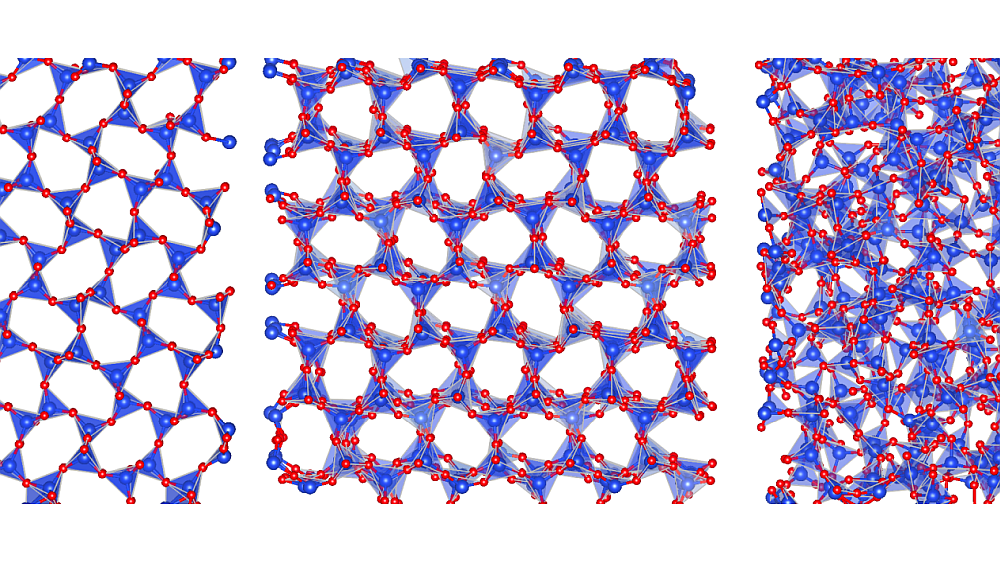[Image above] Simulated vane rheometer. The blades rotate clockwise in the simulation, and suspended spheres are color coded for their originating octant. The yellow indicates low-stress regions, while green represents high-stress regions. Credit: NIST.
The Department of Energy recently announced (pdf) the award of 6 billion core hours of supercomputing time for 59 projects “to accelerate scientific discovery and innovation” through its Innovative and Novel Computational Impact on Theory and Experiment (INCITE) program, now in its tenth year, including one to ACerS Cements Division member Edward Garboczi and his team at NIST. The supercomputers are located Oak Ridge National Laboratory and Argonne National Laboratory.
In the announcement press release, Michael Papka, director of Argonne’s computing facility, says “The INCITE program addresses the largest, most computationally pressing projects in science and engineering.”
Such descriptions tend to conjure images of exotic nanomaterials, metamaterials, and other weird compounds—not a material as ubiquitous as concrete. However, the NIST team was awarded 40 million hours per year for two years for Phase III of a study on concrete rheology.
The cement and concrete industry is the backbone of the construction industry worldwide, and one market research report estimates its global value in 2012 was $450 billion. According to the National Ready Mixed Concrete Association website, concrete’s utility results from a careful balance of constituents.
The key to achieving a strong, durable concrete rests on the careful proportioning and mixing of the ingredients. A concrete mixture that does not have enough paste to fill all the voids between the aggregates will be difficult to place and will produce rough, honeycombed surfaces and porous concrete. A mixture with an excess of cement paste will be easy to place and will produce a smooth surface; however, the resulting concrete will be more likely to crack and be uneconomical.
A properly proportioned concrete mixture will possess the desired workability for the fresh concrete and the required durability and strength for the hardened concrete. Typically, a mixture is by volume about 10 to 15 percent cement, 60 to 75 percent aggregates and 15 to 20 percent water. Entrained air bubbles in many concrete mixtures may also take up another 5 to 8 percent.
Portland cement’s chemistry comes to life in the presence of water. Cement and water form a paste that surrounds and binds each particle of sand and stone. Through a chemical reaction of cement and water called hydration, the paste hardens and gains strength.
The character of concrete is determined by the quality of the paste. The strength of the paste, in turn, depends on the ratio of water to cement. The water-cement ratio is the weight of the mixing water divided by the weight of the cement. High-quality concrete is produced by lowering the water-cement ratio as much as possible without sacrificing the workability of fresh concrete. Generally, using less water produces a higher quality concrete provided the concrete is properly placed, consolidated and cured.
Garboczi and his NIST colleagues are using sophisticated computational methods to optimize the instruments used to measure concrete rheology. The team provided the following summary of the challenges involved in measuring rheology, which trace back to rheometer design parameters, and how new rheometers might be designed using advanced methods like additive manufacturing. The work applies beyond concrete, too.
For more information, see the publication list at the end, or Garboczi’s article in the May 2013 ACerS Bulletin.
Computational design of novel mortar and concrete rheometers: Bridging the length scales of concrete rheology
By Edward Garboczi, Nicos Martys, Judith Terrill, and William George
A team of researchers from NIST’s Information Technology Laboratory (ITL) and Engineering Laboratory (EL) have been awarded 40 million hours of computer time per year for 2014 and 2015 from the Department of Energy (DOE) to support the study of the design of rheometers for large-particle dense suspensions such as concrete. The award is the result of a proposal submitted to DOE’s peer reviewed INCITE program and is the third straight INCITE award for this team and general topic. The research team includes William George, Marc Olano, Steven Satterfield, and Judith Terrill of ITL, Nicos Martys and Edward Garboczi of EL, and Pascal Hebraud of CNRS/ESPCI (France). The simulations will be run in the Leadership Computing Facility of Argonne National Laboratory on ‘Mira’, an IBM Blue Gene/Q system currently ranked number 5 in the “Top 500” list of supercomputer installations.
Accurately measuring the rheology of dense suspensions like concrete is a crucial and widespread problem in the construction and other industries. Two rheological parameters, plastic viscosity and yield stress, are necessary to explain and predict fresh concrete flow properties or indeed almost any dense suspension. However, the usual rheometer geometry used, a spinning vane with some shape blade, does not permit an analytical solution of internal fluid flow, so that neither fundamental rheological parameter can be measured. In the first INCITE phase of this work (3 years, 2.25 million hours) , the basic smooth-particle hydrodynamics computations needed to compute the shear rheology of complex suspensions consisting of a non-Newtonian matrix fluid and a high volume fraction of solid particles (either model spheres or real industrial mineral shapes) were developed and validated. Phase II (3 years, 70 million hours) applied these computations to common industrial rheometers and used the results to design standard reference materials for dense suspensions that can be used to convert empirical experimental measurements into fundamental rheological quantities. In both cases, massively parallel computations were needed to handle the large number of particles and the complex particle-particle interactions necessary for an accurate simulation.
In the just-awarded Phase III INCITE award, computations will be run to design the actual vane rheometer blades themselves and optimize their shape and rotational speed so as to avoid artifacts like sedimentation, particle segregation, and low-shear regions that are present in currently available rheometers. Novel, non-traditional rheometer blade designs, suggested by the simulations, which look nothing like current blade designs, will be built using additive manufacturing processes. This opens up the potential design space, leading to an almost unlimited range of possibilities. Massively parallel computations are needed to guide this manufacturing design and fabrication process, so as to produce optimal rheometers for practical industrial use. NIST has the capability to manufacture these new designs, as well as perform experimental validation of the predicted rheological measurements produced by these novel rheometer blade designs. The results of this work will also be useful for the many industries that make use of dense, complex suspensions, such as food processing, water treatment, coatings, ceramic processing, and pharmaceuticals.
Finally, an integral part of this work, over all three INCITE phases, has been to break down the multi-scale dense suspension material problem into manageable chunks and then reunite the major length scales of concrete rheology: cement paste, mortar, and concrete. Each length scale (cement paste—100s of micrometers, mortar—millimeters, concrete—hundreds of millimeters) has its own separate rheological behavior and complexities and its own rheometers. Cement paste (cement plus water plus chemical additives) is a non-Newtonian fluid with fundamental properties that can be measured with standard parallel plate rheometers. Mortar is modeled as a sand suspension in a cement paste fluid matrix with measured properties, while concrete is considered to be a gravel suspension in a mortar fluid matrix. The Phase III simulations will unite these length scales for traditional and novel rheometer designs, with the aid of computationally-designed standard reference materials and rheometers for each length scale.
Selection of papers associated with this project:
- N.S. Martys, M. Khalil, W.L. George, D. Lootens and P. Hébraud, “Stress propagation in a concentrated colloidal suspension under shear,” Eur. Phys. J. E Volume 35, No 3, 12012-12020, 2012.
- J.W. Bullard, E.J. Garboczi, W.L. George, N.S. Martys, S.G. Satterfield, J.E. Terrill, Advancing the Materials Science of Concrete with Supercomputers, Concrete International, Vol 33, no. 1, Jan 2011, pp. 24-29.
- N.S. Martys, W.L. George, Byong-Wa Chun, D. Lootens, ” A smoothed particle hydrodynamics-based fluid model with a spatially dependent viscosity: application to flow of a suspension with a non-Newtonian fluid matrix” Rheologica ACTA, volume 49, No. 10, 1059-1069 2010.
- Zhu H., Martys N., Ferraris C.F., De Kee D.” A numerical study for the flow of Bingham-like fluids in two dimensional vane and coaxial cylinders using a Smoothed Particle Hydrodynamic (SPH) based method” J. of Non-Newtonian Fluid Mechanics vol.165 pp363-375 (2010).
- N. Martys, D. Lootens, W. L. George and P. Hebraud, Contact and Stress Anisotropies in Start-Up Flow of Colloidal Suspensions, Physical Review E, 80, 2009. ID: 031401. Note: Phys. Rev. E, 80, 031401, 7 pages, (2009).
- N. S. Martys, D.Lootens, W. L. George, S.G. Satterfield, P. Hebraud, “Spatial-Temporal Correlations at the Onset of Flow in Concentrated Suspensions,” XVth Inter. Cong. on Rheology, Ed. A. Co, L. G. Leal, R. H. Colby, A. J. Giacomin, AIP Conf Proc. vol 1027, Monterey, CA, pp. 207-209, 2008.
- D. Lootens, N. S. Martys, W. George, S. Satterfield, P.Hebraud, “Stress Chains Formation under Shear of Concentrated Suspension,” XVth Inter. Cong. on Rheology, Ed. A. Co, L. G. Leal, R. H. Colby, A. J. Giacomin, AIP Conf Proc. vol 1027, Monterey, CA, pp. 677-679, 2008.
- N. S. Martys, D. Lootens, W. L. George, S. Satterfield and P.Hebraud, Spatial-Temporal Correlations at the Onset of Flow in Concentrated Suspensions in The 15th International Congress on Rheology, Monterey, CA, August 2008.
- S. T. Erdogan, N. S. Martys, C. F. Ferraris, D. W. Fowler, “Influence of the shape and roughness of inclusions on the rheological properties of a cementitious suspension,” Cement & concrete composites, vol. 30, no. 5, pp. 393-402 , 2008.
- N. S. Martys, C. F. Ferraris, V. Gupta, J.H. Cheung, J. G. Hagedorn, A. P. Peskin and E. J. Garboczi, Computational Model Predictions of Suspension Rheology: Comparison to Experiment in The 12th International Conference on the Chemistry of Cement, Montreal, Canada, July 2007.
- N. S. Martys, Study of a Dissipative Particle Dynamics Based Approach for Modeling Suspensions, Journal of Rheology, 49(2), 2005, pp. 401-424.
- J. S. Sims and N. S. Martys, Simulation of Sheared Suspensions with a Parallel Implementation of QDPD, Journal of Research of NIST, 109(2), pp. 267-277 (2004).
Author
Eileen De Guire
CTT Categories
- Cement
- Modeling & Simulation



